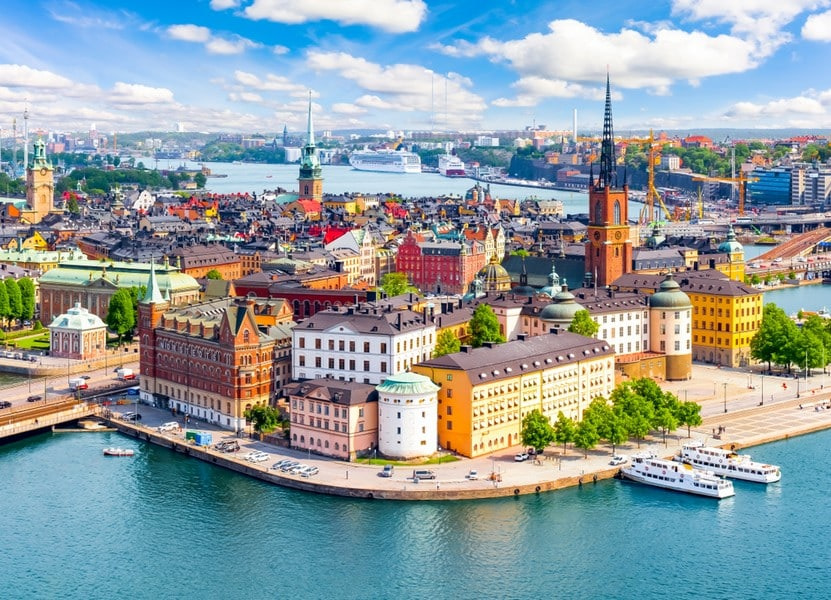
The Bloomberg Global Health Index ranks countries based on how healthy their populations are. It includes objective health metrics that are compiled from authoritative sources like the World Health Organization, the World Bank, and national health ministries.
The index looks at life expectancy, infant mortality, and causes of death, as well as risk factors such as obesity, high blood pressure, tobacco use, and elevated blood glucose. It also accounts for environmental and public health indicators, including access to clean water, sanitation, and air quality. This makes it one of the most useful tools for comparing health between nations in real, measurable terms.
Here are the healthiest countries in the world, according to the latest Bloomberg Global Health Index rankings. Countries are scored out of 100, with higher scores reflecting healthier populations.
Healthiest Countries in World (2025)
| Rank | Country | Health Score | Life Expectancy (yrs) | Obesity Rate (%) | Smoking Rate (%) |
|---|---|---|---|---|---|
| 1 | Singapore | 95.3 | 85.2 | 6.1 | 10.1 |
| 2 | Japan | 95.1 | 84.8 | 4.3 | 16.7 |
| 3 | South Korea | 94.3 | 83.5 | 5.9 | 18.0 |
| 4 | Taiwan | 94.2 | 81.1 | 7.2 | 13.2 |
| 5 | Israel | 94.2 | 83.5 | 26.1 | 19.8 |
| 6 | Norway | 93.6 | 83.5 | 23.1 | 10.0 |
| 7 | Iceland | 93.5 | 83.1 | 21.9 | 9.1 |
| 8 | Sweden | 93.4 | 83.3 | 20.6 | 7.3 |
| 9 | Switzerland | 93.1 | 84.0 | 11.3 | 20.5 |
| 10 | Netherlands | 92.8 | 82.4 | 20.4 | 18.8 |
Top 10 Healthiest Countries in the World
1. Singapore

Singapore is the healthiest country on Earth. Its population enjoys one of the highest life expectancies globally, 85.2 years, while also ranking near the top in sanitation, disease control, and preventive care. The government operates a tightly controlled, efficient public health system. Universal healthcare is funded through mandatory savings accounts and subsidies, keeping costs manageable. Clinics and hospitals are modern, regulated, and monitored for quality. Obesity and smoking rates are among the lowest in the world.
Singapore’s dense urban design reduces reliance on cars, promoting walking and transit use. Strict pollution control laws keep air and water clean. National fitness campaigns, school-based health education, and early screening programs all contribute to strong health outcomes. Singapore’s proactive approach to health policy makes it a model for global public health.
2. Japan

Japan ranks second due to a mix of tradition, policy, and discipline. The Japanese diet, rich in rice, fish, vegetables, and fermented foods, helps keep obesity rates below 4%. The country’s approach to portion control, minimal processed foods, and strong community ties reinforces healthy habits from a young age.
The country has one of the most systematic efforts in the world to manage obesity at the national level. Established in 2008, the Metabo Law requires all adults aged 40 to 74 undergo mandatory annual waistline measurements as part of routine health checks. Employers and regional governments face financial penalties if too many insured workers fail to meet improvement targets over time.
Healthcare in Japan is universal and affordable. Life expectancy averages around 84.8 years, with women living even longer. Smoking rates have fallen significantly, and physical activity remains embedded in daily life, especially among the elderly.
3. South Korea

South Korea has engineered a dramatic transformation in public health over the last 40 years. Once struggling with poverty and infectious disease, it now ranks among the healthiest countries globally. The national health insurance program covers nearly the entire population. South Korea invests heavily in preventive medicine, with widespread cancer screening, mandatory vaccinations, and digital health records that track patient care across providers.
Obesity rates are low, especially among women, and life expectancy is 83.5 years. Smoking has declined, and the government runs aggressive public health campaigns to promote healthy eating and exercise.
Urban life is active. Cities are walkable and served by extensive public transport networks. Mental health remains a challenge, particularly among youth, and high stress levels are a concern. But as a whole, South Korea’s balance of modern medicine and cultural norms keeps the population exceptionally healthy.
4. Taiwan

Taiwan’s health system is one of the most efficient in the world. The single-payer National Health Insurance (NHI) covers almost all citizens and residents, offering low-cost access to hospitals, specialists, and medications. Out-of-pocket expenses are minimal, and quality is high.
The country emphasizes early intervention and preventative care. Regular check-ups, cancer screenings, and health education programs are the norm. The result is a life expectancy of over 81 years, with declining rates of cardiovascular and infectious disease.
Taiwan’s cities are clean and well-regulated. Air and water quality are generally strong, and the environment supports healthy living. While fast food and sedentary habits are increasing, obesity remains below OECD averages.
Taiwan’s response to past health crises, such as SARS and COVID-19, showcases its public health capacity. While political tensions with China create other risks, when it comes to healthcare and wellness, Taiwan is one of the best-performing societies on the planet.
5. Israel

Israel’s health outcomes are a product of a universal healthcare system combined with a Mediterranean lifestyle. Every citizen is covered under one of four government-regulated non-profit health funds. Services include primary care, emergency treatment, chronic disease management, and maternity care.
Israel’s diet, centered around vegetables, legumes, olive oil, and fresh produce, helps keep obesity and heart disease relatively low. Smoking rates have dropped in recent years. Physical activity is common, especially among the young. Life expectancy is about 83 years.
Medical infrastructure is modern, with high levels of innovation and access to advanced treatments. Israel ranks near the top in health technology and digital records.
Israel faces security challenges and social tensions, but these have not significantly affected health outcomes. Public health campaigns remain strong, and the government invests in both urban and rural access. The result is a resilient, high-functioning health system that delivers consistent results.
6. Norway

Norway pairs one of the world’s highest standards of living with a strong national health system. Healthcare is publicly funded and available to all residents. Preventive care, maternity services, vaccinations, and specialist treatment are covered.
Life expectancy exceeds 83 years. Environmental conditions play a major role. Air and water are clean, pollution is minimal, and nature is never far away. Norwegians spend time outdoors year-round, and physical activity is a cultural norm.
The government tracks public health closely. Smoking rates have dropped, and obesity remains below European averages. Alcohol use is regulated, and school nutrition programs promote healthy eating early.
Norway faces rising costs due to an aging population and high demand for services. But with a robust economy and well-managed health sector, the country continues to rank among the world’s healthiest.
7. Iceland

Iceland has a population that thrives on clean air, strong community, and a powerful public health system. The country’s natural environment is a major asset. Geothermal energy keeps pollution low, and food is typically fresh and local. Outdoor recreation is a way of life, supported by public programs and accessible nature.
Healthcare is universal and funded through taxes. Services are comprehensive, from preventive screenings to hospital care. Iceland performs well in key health indicators – low obesity, low maternal mortality, and high vaccination coverage.
The population is small and highly educated. This allows for efficient public communication during health emergencies. Iceland’s size also means that services can be customized and delivered at a personal level. Life expectancy is 83.1 years.
8. Sweden

Sweden ranks eighth in the world for overall health, with high life expectancy, universal healthcare access, and strong environmental health. Life expectancy stands at 83.3 years. The Swedish model emphasizes public health from an early age. Citizens receive routine checkups, vaccinations, and maternal care as standard.
Healthcare is tax-funded and available to all residents. Primary care is the first point of contact, and preventive medicine is widely used to control long-term costs. Patients benefit from electronic health records, minimal bureaucracy, and short wait times for urgent needs.
Lifestyle is central to Sweden’s health advantage. Cities are designed for walking and biking. Physical activity is embedded in culture. Smoking is rare, and obesity rates are low by European standards. Clean air, low population density, and green space contribute to lower disease risk.
9. Switzerland

Switzerland pairs one of the world’s longest life expectancies, about 84 years, with strong chronic disease prevention and world-class hospital care. Its unique system is based on mandatory private insurance, regulated heavily by the government. All citizens are required to carry insurance, and subsidies keep it affordable.
The country has low rates of preventable mortality and consistently ranks well on OECD health indicators. Screening programs are common, and electronic records help streamline patient care. The system encourages competition among providers, which maintains high quality of service.
Lifestyle also plays a major role. Obesity rates are low (around 11%), and most Swiss are physically active. Outdoor recreation is common year-round, with easy access to trails, mountains, and lakes. Smoking is on the decline, and alcohol consumption is moderate.
10. Netherlands

The Netherlands closes the top ten with a healthcare model that combines universal access, efficient primary care, and strong health education. Life expectancy is around 82.4 years, with low maternal and infant mortality and strong mental health services.
Dutch residents are required to carry private health insurance, but premiums are regulated, and the government offers subsidies for lower-income groups. The result is universal access without government-run care. Primary doctors serve as gatekeepers and focus heavily on prevention and early intervention.
The country’s infrastructure supports healthy living. Bicycles outnumber cars in major cities, and physical activity is a daily habit. Fresh produce and balanced meals are central to the Dutch diet. Smoking and obesity rates remain below EU averages, though they’ve risen slightly in recent years.
Why Are These Countries So Healthy?
These nations share common characteristics: high life expectancy, effective public health policy, universal coverage, and healthy cultural habits. Their systems emphasize prevention rather than crisis management. Citizens are encouraged to eat well, move often, and get regular check-ups.

Access to clean air, water, and healthy food is widespread. Childhood health programs begin early. Governments invest heavily in health infrastructure and education. In each country, a cultural commitment to long-term wellness supports national policy.
These countries also take public health seriously, whether enforcing tobacco regulations, taxing sugar, or launching national fitness campaigns. The result is fewer hospitalizations and better quality of life.
How Does the United States Compare?
The U.S. ranks 34th in the Bloomberg index, with a score around 73.
Despite spending more per capita on healthcare than any other nation, the U.S. ranks near the bottom among high-income countries in health outcomes.

The United States falls behind because of widespread lifestyle-related disease, particularly obesity, and a high rate of preventable mortality. Over 42% of American adults are obese, driving up rates of diabetes, heart disease, and stroke. These conditions shorten life expectancy and reduce quality of life.
Unlike peer nations that prioritize prevention, the U.S. relies heavily on reactive treatment. Many Americans skip regular checkups due to high costs, lack of insurance, or fragmented care systems. As a result, diseases that could be managed early often become fatal.
To improve national health, the U.S. must shift from a reactive system to one built on prevention. That means making healthy food affordable, building environments that promote daily physical activity, ensuring access to basic medical care. Social factors like poverty, pollution, and housing also need to be addressed as these shape long-term health. Without this shift in priorities, health outcomes will continue to lag no matter how much is spent on treatment.




























































